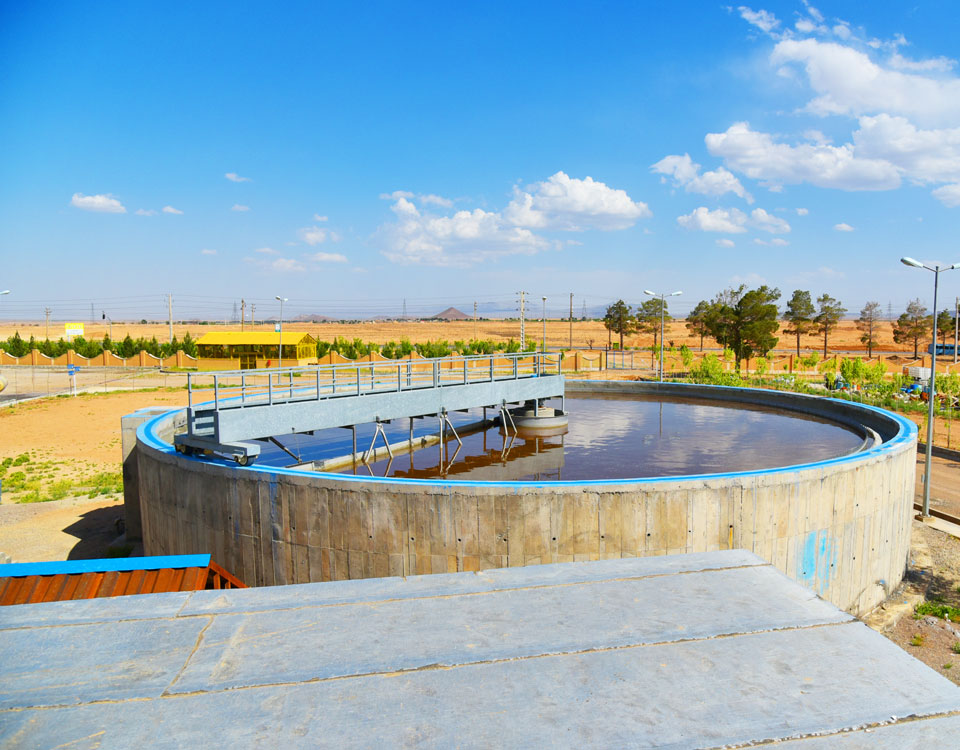Utility
Water purification
Reverse osmosis
Reverse osmosis (RO) is a filtration method with membrane technology which causes to remove different large molecules and ions from solution. As a result, the solute is retained on the pressurized side of the membrane, and the pur solvent is allowed to pass through the other side.How does a reverse osmosis work?
If a semipermeable membrane is located between two solutes with different concentrations, some solute is transferred from one side of the membrane to the other side. The natural direction of the solvent movement (that is from a more chemical potential to the less chemical potential) is in such a way that the thicker solution is diluted. In Figure A, pure water passes through the membrane and enters saline water. If the system is allowed to be balance (Figure B), the level of thicker saline water will be higher than the level of the pure water. The difference of the levels in both sided of the membrane is called "osmotic pressure". Now if a mechanical pressure higher than the osmotic pressure is applied to the saline water, the water molecules are separated from salt molecules and move towards the pure water section. This process is called "reverse osmosis".
What is the difference between reverse osmosis and filtration?
The reverse osmosis process is similar to the applications of the other membrane technology. However, there are key differences between reverse osmosis and filtration. The dominant mechanism of removal in membrane filtration is the pressure application which theoretically results in the complete exit of particles regardless of operating parameters, such as pressure and concentration of wastewater, but the reverse osmosis involves a diffusion mechanism whose separation efficiency depends on the solute concentration, the pressure and the flow rate of the water. The efficiency of a reverse osmosis water filter is affected by the pressure of the inflow water of the system and the temperature of the water. Reverse osmosis membrance is tested at the pressure of 65 PSI and the temperature of 77o F. Any gradual change in either of these two variables causes a change in the membrane performance.Applicable tests in boiler laboratory
| Serial no. | Test | Standard no. |
|---|---|---|
| 1 | Total Dissolved Solid (TDS) | |
| 2 | Electricity Conductivity (EC) | |
| 3 | Acidity (PH) | |
| 4 | Total Hardness (TH) | |
| 5 | Phenol and Total Alkalinity | |
| 6 | Phosphate Residue (PO4) | |
| 7 | Hydrazine residue (N2H4) | |
| 8 | Oxygen residue (O2) |
Applicable tests in the wastewater treatment laboratory
| Serial no. | Test | Standard no. |
|---|---|---|
| 1 | The volume of half an hour biological sludge sedimentation | |
| 2 | COD measurement | |
| 3 | Measurement of phosphate PO4and Nitrogen N | |
| 4 | The measurement of Total Suspended Solids (TSS) | |
| 5 | The measurement of the biological sludge of Mixed Liquor Suspended Solids (MLSS) and Mixed Liquor Volatile Suspended Solids (MLVSS) |
Wastewater Treatment Unit
Every day, while technology is increasingly developed, advanced techniques are presented for the treatment of industrial wastewater. Most of the techniques are a combination of physical, chemical and biological methods which are respectively called preliminary, secondary and final treatment. In order to select an appropriate treatment system, after a complete review of the environmental regulations and the identification of the type and amount of pollutants and the specifications of inflow and outflow wastewater, the purification targets are identified based on which the appropriate method or a desirable combination of them is chosen. All the wastewater treatment units are obviously designed to reduce the amount of pollution, but what is important is to select the best method and the most appropriate system for each industrial unit while all the conditions of wastewater, the processes of the unit and the specifications of the environment receiving wastewater are taken into account. Climate conditions, geographical location, quantitative –qualitative parameters of the sewage and the amount of required treatment based on the local environmental criteria are the other factors to select a wastewater treatment system. The criteria not only are limited to organic compounds for purification but the removal of metal and other pollutants are also considered. The treatment methods often involve more than one process, and the arrangement of the processes is very important in multi-process methods. On the whole, each treatment process follows the below objectives:
• Removing suspended and floating material
• Removing organic and decomposable substances
• Reducing turbidity and color to an acceptable extent
• Eliminating pathologic and non-environmental factors
In general, each treatment process will be appropriate when:
• The output of the process to achieve the desirable targets is acceptable.
• The by-products of sewage are non-toxic and have no adverse side-effects, especially on the environment.
• The concentration of pollutants is low enough to satisfy the environmental laws.
• It is economically feasible.
• Removing suspended and floating material
• Removing organic and decomposable substances
• Reducing turbidity and color to an acceptable extent
• Eliminating pathologic and non-environmental factors
In general, each treatment process will be appropriate when:
• The output of the process to achieve the desirable targets is acceptable.
• The by-products of sewage are non-toxic and have no adverse side-effects, especially on the environment.
• The concentration of pollutants is low enough to satisfy the environmental laws.
• It is economically feasible.

